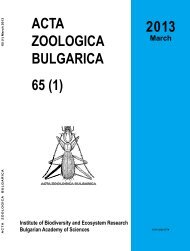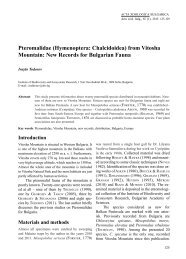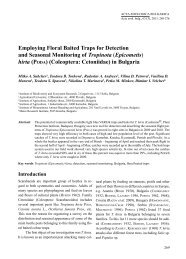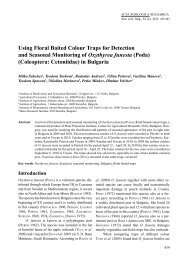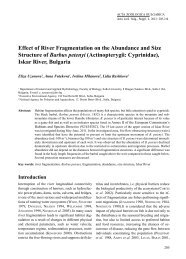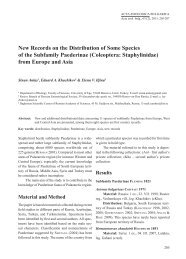Does Black-Winged Kite Elanus caeruleus - Acta zoologica bulgarica
Does Black-Winged Kite Elanus caeruleus - Acta zoologica bulgarica
Does Black-Winged Kite Elanus caeruleus - Acta zoologica bulgarica
Create successful ePaper yourself
Turn your PDF publications into a flip-book with our unique Google optimized e-Paper software.
ACTA ZOOLOGICA BULGARICA<br />
<strong>Acta</strong> zool. bulg., 64 (2), 2012: 209-214<br />
<strong>Does</strong> <strong>Black</strong>-<strong>Winged</strong> <strong>Kite</strong> <strong>Elanus</strong> <strong>caeruleus</strong> (Desfontaines,<br />
1789) Have an Expansion in its Range in Turkey?<br />
Recep Karakaş<br />
Dicle University, Science Faculty, Department of Biology, 21280 Diyarbakır, Turkey; E-mail: rkarakas@dicle.edu.tr<br />
Abstract: The status and distribution of <strong>Black</strong>-winged kite <strong>Elanus</strong> <strong>caeruleus</strong> (Desfontaines, 1789), which has an expansion<br />
in its range, were analysed in Turkey. The long-term records were analyzed as breeding and nonbreeding<br />
season and main areas were mapped by GIS (Geographical Information System) programme<br />
together with habitat data’s for determination of distribution in Turkey. For showing the expansion, regression<br />
analysis has been used for showing the increase of species observations for three time periods.<br />
The results indicated two regions, mainly after 1990s; Mediterranean and South-eastern Anatolia where<br />
this expansion was evident. Comparison of the historic and recent distribution of <strong>Black</strong>-winged kite records<br />
in Turkey shows a change in their distribution. It was concluded that there is a little increase in its<br />
expansion in southern part of country; mainly in South-eastern Anatolia region, related to breeding population<br />
in Iraq and Iran. Species has showed an expansion on its range, and probably this will be continuing<br />
in future. Further investigations and observations are needed.<br />
Key words: <strong>Black</strong>-winged kite, <strong>Elanus</strong> <strong>caeruleus</strong>, distribution, ecological changes, expansion, status, Turkey<br />
Introduction<br />
The <strong>Black</strong>-winged kite, <strong>Elanus</strong> <strong>caeruleus</strong><br />
(Desfontaines, 1789) is a small diurnal raptor bird<br />
species typical for open areas. It is classified as being<br />
in the Least Concern category by IUCN (IUCN<br />
2009) while in the SPEC 3 category as a vulnerable<br />
species in Europe (Tu c k e r & He aT H 1994). The nominate<br />
form E. <strong>caeruleus</strong> <strong>caeruleus</strong> shows distribution<br />
most of Africa (mainly sub-Saharan), south-west<br />
of Europe, south Asia and south-west of Arabian<br />
Peninsula (d e l Ho y o et al. 1994, cr a m p 1998,<br />
Fe r g u s o n-le e s & cHrisTie 2001). In Mediterranean<br />
region, it is revealed as native in Morocco, Tunisia,<br />
Egypt and Algeria. In south-western Europe species<br />
is native in Spain and Portugal, and extended its distribution<br />
to south-western France after 1990s (me b s<br />
& sc H m i d T 2006). Species has been showing an expansion<br />
in some parts of its range, mainly from its<br />
original range in Africa to the northwards (del Ho y o<br />
et al. 1994, me b s & sc H m i d T 2006), and reported<br />
from some west Palaearctic countries as vagrant.<br />
The probable cause of expansion in some countries<br />
reported is formation of suitable feeding and breeding<br />
areas by deforestation together with increase<br />
in voles and mice population (ma ñ o s a et al. 2005,<br />
me b s & sc H m i d T 2006). Also, this situation may<br />
have been consequence of changing feeding preferences<br />
or trying to use food resource in unoccupied<br />
areas. Although species has a range expansion, loss<br />
of suitable habitats and some pesticides were reported<br />
as a threat for species in some countries (me b s &<br />
sc H m i d T 2006).<br />
Although, it is revealed as vagrant in Turkey,<br />
our information on status and distribution of species<br />
is unclear (be a m a n 1986, ma rT i n s 1989, ki r w a n<br />
209
Karakaş R.<br />
et al. 2003). Most of the earlier general studies revealed<br />
the species as vagrant for Turkey based on<br />
records given mainly from the western half of the<br />
country (ka s pa r e k & bilgin 1996). The occurrence<br />
of species in eastern half of country was confirmed<br />
during the last decade (Ka r a K a ş 2005). Interestingly,<br />
the last records are concentrated in South-eastern<br />
Anatolia where it is reported after 1998 as a result<br />
of supposed expansion. The ecological changes that<br />
happen in this part of Turkey (we l c H 2004) may be<br />
in favour of species. It is known that the occurrence<br />
of most of species is often related to the availability<br />
of suitable habitat including food. There is no any<br />
study on the status and distribution of <strong>Black</strong>-winged<br />
kite in Turkey and this is the first preliminary study.<br />
It was aimed to make a contribution to the understanding<br />
current status, distribution and expansion<br />
of <strong>Black</strong>-winged kite which is relatively poorly<br />
known species in Turkey, associated with habitat<br />
types based on observations and recent literature.<br />
Material and methods<br />
All of the available records of <strong>Black</strong>-winged kite between<br />
1876-2009 were evaluated for determine the<br />
distribution of species in Turkey. Records were obtained<br />
from all published studies on distribution of<br />
birds in Turkey, including Turkey Bird Reports and<br />
personal observations. All of the records were evaluated<br />
and they were mapped by GIS (Geographical<br />
Information System) programme – Arcmap 9.2 version<br />
– together with habitat data’s for determination<br />
of distribution in Turkey. For showing the expansion,<br />
regression analysis has been used for showing<br />
increase comparing three periods: 1875-1925, 1925-<br />
1975 and 1975-2009.<br />
Results<br />
All of the available records of <strong>Black</strong>-winged kite<br />
from Turkey (Table 1) were evaluated and main areas<br />
were mapped for determine the distribution of<br />
species in the country together with habitat data (Fig.<br />
1). Habitat characteristics of the areas where species<br />
was recorded have differences, at least macro level.<br />
In total, 19 individuals were reported; 15 during the<br />
breeding season (from March to August) and four<br />
during the non-breeding season from Turkey for<br />
the period 1876-2009. Results suggest that most of<br />
the Turkish breeding season records reported from<br />
210<br />
Mediterranean and Marmara regions followed by<br />
South-eastern and Central Anatolia regions. Nonbreeding<br />
season records were reported from two<br />
regions; Mediterranean (January 1876, Table 1)<br />
and Marmara regions (October 1931, Table 1). In<br />
addition, the species was not reported from <strong>Black</strong><br />
Sea, Aegean and East Anatolia regions during the<br />
last century. On the other hand, although the earlier<br />
records reflect distribution of the species in Marmara<br />
region, the recent records indicate two other regions:<br />
Mediterranean and South-eastern Anatolia regions,<br />
mainly after 1990s.<br />
Mediterranean Region: There are four records<br />
from this region one of which is non-breeding season<br />
(January) while three of them belong to breeding<br />
season without evidence of breeding.<br />
South-eastern Anatolia: There are four<br />
records from this region between 1998-2009 years<br />
and all of them belong to the breeding season but<br />
without evidence of breeding. Before 1998, the species<br />
were not reported from this region. ki r w a n et al.<br />
(2003) stated that species has apparently colonised<br />
large parts of Iraq and mentioned my own record<br />
with reflection of the same expansion. The following<br />
years this hypothesis was supported by records that<br />
showed expansion of the species in that part of the<br />
country. The habitats where the species was recorded<br />
in this region meet the requirements described for it<br />
associated with the presence of dry cereal crops. On<br />
the other hand, the expansion of species may have<br />
been supported by climatic and agricultural regime<br />
changes due to GAP (South-eastern Anatolia Project)<br />
which is a comprehensive development project contain<br />
a number of huge dams and irrigation canals<br />
with their applications in this region (we l c H 2004).<br />
The recent expansion of species may have been reflection<br />
of new conditions arisen from ecological or<br />
climatically changes that happen in the region which<br />
enable the species to use new areas.<br />
Comparing the proportion of records between<br />
1876-1990 and 1990-2009, it was found that there is<br />
an increase in the frequency of records and the presence<br />
rate significantly increased between 1990 and<br />
2009 years may be related to reflection of expansion<br />
in Turkey (Table 2). Regression analyses according<br />
to per fifty years support the mentioned increase, too<br />
(Fig. 2). Also, comparison of the historic and recent<br />
distribution of <strong>Black</strong>-winged kite records in Turkey<br />
shows a change in their distribution.
<strong>Does</strong> <strong>Black</strong>-winged <strong>Kite</strong> <strong>Elanus</strong> <strong>caeruleus</strong> (Desfontaines, 1789) have an expansion in its range...<br />
Table 1. All records of <strong>Black</strong>-winged kite in Turkey between 1876-2009.<br />
Region Location Dates<br />
Individual<br />
Number<br />
Source / Observer<br />
Mediterranean İçel January 1876 2 da n F o r d (1878)<br />
Adana 11 April 1935 2 bi r d (1937)<br />
Antalya Yamansız 12 Apr 1998 2 Er d o ğ a n et al. (2002)<br />
Göksu Delta 24-25 Apr 2006 1 ba l m e r & be T To n (2006)<br />
C Anatolia 20 km East of Niğde 1 Aug 1984 1 ma rT i n s (1989)<br />
SE Anatolia<br />
50th km of Diyarbakır-<br />
Bingöl way<br />
*28 Mar 1998 1 r. ka r a k a s, ki r w a n et al (2003)<br />
15 km East of Diyarbakır 7 Apr 2004 1 Ka r a K a ş (2005)<br />
40th km of Diyarbakır-<br />
Bingöl way<br />
18 Apr 2009 1 r. ka r a k a s<br />
Silvan-Bismil way 13 May 2009 1 r.mu n g a n<br />
Marmara Bosporus 14 Oct 1931 1 ku m e r l o e v e (1958), ki r w a n et al (2008b)<br />
Bosporus 21 Oct 1931 1 ku m e r l o e v e (1958), ki r w a n et al (2008b)<br />
Bosporus March 1933 1 ku m e r l o e v e (1958), ki r w a n et al (2008b)<br />
Bosporus 6 April 1933 1 ku m e r l o e v e (1958), ki r w a n et al (2008b)<br />
Bosporus 17 April 1953 2 ku m e r l o e v e (1958), ki r w a n et al (2008b)<br />
Uluabat Gölü 17 April 1968 1 OST (1972).<br />
*This record reported as 6 May 1999 by mistake by ki r w a n et al. (2003).<br />
Fig. 1. Distribution of breeding and non-breeding season records across different habitat (dots are indicating breeding<br />
season; stars are indicating non-breeding season records).<br />
211
Karakaş R.<br />
Table 2. Statistic analysis of all records in Turkey (by Chi-square test, P=0.007, confidence interval 95%).<br />
Between 1876 to 1990<br />
From 1990 to 2009<br />
Total (From 1876 to 2009)<br />
Discussion<br />
Ornithological activities increased in the Turkey during<br />
last decades, in general, but presumably this is<br />
not the exact reason of increase in records of the species<br />
in country when we take into account ecological<br />
characteristics of species together with experiences<br />
in other countries. The available records indicate<br />
distribution of species is restricted to a few localities,<br />
mainly in Mediterranean and South-eastern part<br />
of Turkey, based on records after 1990s. Also, there<br />
is probability of breeding of species in some part of<br />
the South-eastern Anatolia, where suitable habitats<br />
both for feeding and breeding exist. The agricultural<br />
activities in this region may hold good feeding conditions<br />
for the species, if the negative effects of pesticides<br />
unconsidered. The pesticide applications may<br />
be limiting factors on this expansion in the future.<br />
During the last years, <strong>Black</strong>-winged kite has a<br />
range expansion in Europe (me b s & sc H m i d T 2006),<br />
in the Middle East with an apparent increase was re-<br />
212<br />
Individual numbers<br />
Bird<br />
Absence Presence<br />
0 1<br />
Total<br />
Year number 103 12 115<br />
% within 89.6% 10.4% 100.0%<br />
Year number 12 7 19<br />
% within 63.2% 36.8% 100.0%<br />
Year number 115 19 134<br />
% within 85.8% 14.2% 100.0%<br />
The 50-year periods<br />
Fig. 2. Regression analyses for three periods (1876-1925, 1926-1975 and 1976 to 2009).<br />
ported in Egypt (ki r w a n et al. 2008b). The birds recorded<br />
in Turkey and the Middle-east may have originated<br />
from north-east Africa, particularly from Egypt,<br />
where the species is native (bi r dliFe 2009). Also,<br />
species revealed as vagrant in Israel, Lebanon and<br />
Syria mainly based on historical records (mu r d o c H<br />
& beTTon 2008; ra m a d a n-Ja r a d i et al. 2008). The<br />
breeding was confirmed in Iraq and Iran during last<br />
decade (sa l i m 2002, sc o T T & ad H a m i 2006).<br />
Although species revealed as a vagrant in Turkey<br />
(ki r w a n et al. 2003,2008a,2008b), there is a little increase<br />
in its expansion in southern part of country;<br />
mainly in South-eastern Anatolia due to ecological<br />
changes were reported including climate changes because<br />
of large dam reservoirs in the region, mainly<br />
after 1990s (welcH 2004). The increase in dams and<br />
irrigation canals may lead to an enormous increase in<br />
agricultural areas and resulted in a considerable extension<br />
of feeding areas for species. Related to the
<strong>Does</strong> <strong>Black</strong>-winged <strong>Kite</strong> <strong>Elanus</strong> <strong>caeruleus</strong> (Desfontaines, 1789) have an expansion in its range...<br />
correlation between land-use change and presence of<br />
species (ba l b o n T i n et al. 2008), agricultural regime<br />
changes together with other ecological components<br />
may have support this expansion in South-eastern part<br />
of Turkey. On the other hand, <strong>Black</strong>-winged kites are<br />
able to disperse over long distances and as the region<br />
is close to the Iraq and Iran that probably supported<br />
this expansion together with species mobility due to<br />
species response to food supply (Fe r g u s o n-lees &<br />
cHrisTie 2001). The <strong>Elanus</strong> species are rodent specialists<br />
and their distribution, population sizes and movements<br />
are largely dependent on rodent abundance and<br />
availability (me n d e l s o H n & Ja k s i c 1989, ba l b o n T i n<br />
et al. 2008). Also, climate change should be considered<br />
another factor due to its different effects on many<br />
bird species by change of breeding or wintering ranges<br />
(cr i c k 2004, cH a m b e r s et al. 2005, HunTley et al.<br />
2006) together with potentially unknown factors that<br />
might affect bird distribution ranges.<br />
Consequently, species range is showing an<br />
expansion in western Asia, at least in Iraq, Iran<br />
References<br />
ba l b o n T i n J., J. J. ne g r o, J. H. sa r a s o l a, J. J. Fe r r e r o and d.<br />
riviera 2008. Land-use changes may explain the recent<br />
range expansion of the <strong>Black</strong>-shouldered <strong>Kite</strong> <strong>Elanus</strong><br />
<strong>caeruleus</strong> in southern Europe. – Ibis, 150: 707-716<br />
balmer d. and k. beTTon 2006. Around the region. – Sandgrouse,<br />
28 (2): 184-192.<br />
be a m a n m. 1986. Turkey Bird Report 1976-81. – Sandgrouse,<br />
8: 1-41.<br />
bi r d c.g. 1937. The birds of southern Asia Minor from Mersin<br />
to the Euphrates. – Ibis, (XIV) 1: 65-85.<br />
bi r dliFe in T e r n aT i o n a l 2009. Species factsheet: <strong>Elanus</strong> <strong>caeruleus</strong>.<br />
.<br />
cH a m b e r s l. e., l. Hu g H e s and m. a. we s T o n 2005. Climate<br />
change and its impact on Australia’s avifauna. – Emu,<br />
105: 1-20.<br />
cr a m p s. 1998. The Complete Birds of the Western Palearctic.-<br />
Oxford University Press. (on CD-ROM).<br />
cr i c k H.Q.p. 2004. The impact of climate change on birds. – Ibis,<br />
146 (Suppl. 1): 48-56.<br />
da n F o r d c. g. 1878. A contribution to the ornithology of Asia<br />
minor. – Ibis, (IV) 2: 1-35.<br />
Er d o ğ a n a., M. Öz, H. SE rt and r. Tu n ç 2002. Antalya-Yamansaz<br />
Gölü ve Yakın Çevresinin Avifaunası ve Herpetofaunası<br />
(Herpetofauna and Avifauna of Antalya-Yamansaz Lake<br />
and its surrounding). – Ekoloji, 10 (43): 33-39.<br />
Fe r g u s o n-le e s J. and d. a. cHrisTie 2001. Raptors of the World.-<br />
Christopher Helm, London.<br />
d e l Ho y o J., a. el l i o T T and J. sa r g aTa l (Eds.) 1994. Handbook<br />
of the Birds of the World. Vol 2. New World Vultures to<br />
Guineafowl. Barcelona, Lynx Edicions.<br />
(sa l i m 2002, sc o T T & ad H a m i 2006) and some part<br />
of Turkey like in south-western Europe (bi r dliFe<br />
2009). Species can be considered as vagrant for<br />
Turkey now with probability of breeding in the<br />
South-eastern Anatolia region related to expansion<br />
of breeding population in Iraq and Iran (sa l i m 2002,<br />
sc o T T & ad H a m i 2006), but frequency of records<br />
indicate the status of species will change in future.<br />
Although there is no quantitative data, expansion of<br />
this species in Turkey, probably, may be related to<br />
abundance of preferred food in previously unoccupied<br />
areas for it like as another some Mediterranean<br />
countries (ma ñ o s a et al. 2005). More research is<br />
needed in order to understand the reasons for the recent<br />
range expansion. Furthermore, detailed information<br />
on habitat requirements, breeding numbers<br />
and population trends is required.<br />
Acknowledgments: I would like to thank to Prof.Dr. Alpaslan<br />
Kemal Tuzcu for his help on the manuscript and Recep Mungan<br />
for a record. And also to thank to Doğa Derneği (Nature Association)<br />
and Ferdi Akarsu for their helps for habitats data and map.<br />
Hu n T l e y b., y. c. co l l i n g H a m, r. e. gr e e n, g. m. Hi lT o n, c.<br />
ra H b e k and s. g. wi l l i s 2006. Potential impacts of climate<br />
change upon geographical distributions of birds. – Ibis,<br />
148: 8-28<br />
IUCN 2009. Red List of Threatened Species. . Downloaded on 20 May 2009.<br />
Ka r a K a ş r. 2005. <strong>Black</strong>-winged <strong>Kite</strong> <strong>Elanus</strong> <strong>caeruleus</strong> from<br />
Turkey. – Acrocephalus, 26 (126): 162.<br />
ka s pa r e k m. and c. c. bilgin 1996. Kuşlar (Aves). – In: ke n c e<br />
a. and c.c. bilgin (Ed.): Türkiye Omurgalılar Tür Listesi<br />
(Species List for Vertebrates of Turkey). Tübitak, Ankara,<br />
Turkey, 27-87.<br />
Ki r w a n G. M., M. Öz E n, B. Ku rt and r. p. ma rT i n s 2003. Turkey<br />
Bird Report 1997–2001. – Sandgrouse, 25 (1):8-31.<br />
Ki r w a n G. M., M. Öz E n, and b. de m i r c i (comp) (2008a). Turkey<br />
Bird Report 2002–2006. – Sandgrouse, 30:166-189.<br />
Ki r w a n G. M., K. Bo y l a, P. Ca S t E l l, B. dE M i r C i, M. Öz E n, H.<br />
we l c H and T. ma r l o w. 2008b. The birds of Turkey. Christopher<br />
Helm, London.<br />
ku m e r l o v e H. 1958. Vom Vorkommen des Gleitaars, <strong>Elanus</strong><br />
<strong>caeruleus</strong> (Desf.) am Bosporus und in der Türkei. –<br />
Vogelwarte, 19: 210.<br />
ma ñ o s a s., g. mo n T é s, g. bo Ta and J. bo n F i l 2005. <strong>Black</strong>shouldered<br />
<strong>Kite</strong> <strong>Elanus</strong> <strong>caeruleus</strong> diet in an area recently<br />
colonized in the north-east of the Iberian Peninsula.- Revista<br />
Catalana Ornitologia, 21: 11-16.<br />
ma rT i n s r. p. 1989. Turkey Bird Report 1982-86. – Sandgrouse,<br />
11: 1-41.<br />
me b s T. and d. sc H m i d T 2006. Die Greifvögel Europas, Nordafrikas<br />
und Vorderasiens Biologie, Kennzeichen, Bestände. –<br />
213
Karakaş R.<br />
Franckh-Kosmos Verlags GmbH and Co. KG Stuttgart.<br />
me n d e l s o H n J. m. and F. m. Ja k s i c 1989. Hunting behaviour of<br />
<strong>Black</strong>-shouldered <strong>Kite</strong>s in the Americas, Europe, Africa<br />
and Australia. – Ostrich, 60: 1-12<br />
mu r d o c H d. a. and k. F. be T To n 2008. A check list of Birds of<br />
Syria. – Sandgrouse, (Suppl. 2): 1-48.<br />
OST 1972. Turkey Bird Report 1968-69. – Ornithological Society<br />
of Turkey, London.<br />
ram a d a n-Ja r a d i g., T. ba r a and m. ra m a d a n-Ja r a d i 2008.<br />
Revised Checklist of the birds of Lebanon, 1999-2007. –<br />
Sandgrouse, 30 (1): 22-69.<br />
214<br />
sa l i m m. a. 2002. The first records, including breeding of <strong>Black</strong>winged<br />
<strong>Kite</strong> <strong>Elanus</strong> <strong>caeruleus</strong> in Iraq. – Sandgrouse, 24<br />
(2): 136-138.<br />
sc o T T d. a. and a. ad H a m i 2006. An updated checklist of birds<br />
of Iran. – Podoces, 1:1-16.<br />
Tu c k e r g. m. and m. F. He aT H 1994. Birds in Europe: their conservation<br />
status. – Birdlife International, Cambridge.<br />
we l c H H. J. (Ed.) 2004. GAP Biodiversity Research Project<br />
2001-2003 / Final Report. – DHKD (Doğal Hayatı Koruma<br />
Derneği). İstanbul, Türkiye.<br />
Received: 03.10.2011<br />
Accepted: 13.02.2012



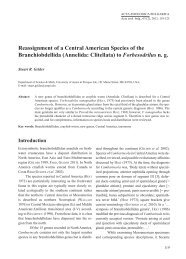
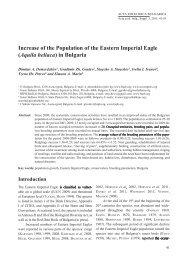
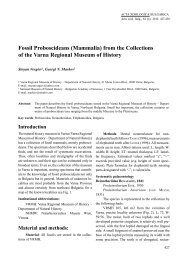
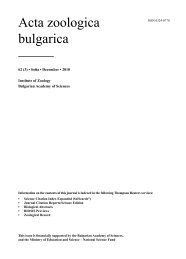
![table of contents [PDF] - Acta zoologica bulgarica](https://img.yumpu.com/52655254/1/186x260/table-of-contents-pdf-acta-zoologica-bulgarica.jpg?quality=85)
![table of contents [PDF] - Acta zoologica bulgarica](https://img.yumpu.com/52655255/1/186x260/table-of-contents-pdf-acta-zoologica-bulgarica.jpg?quality=85)
